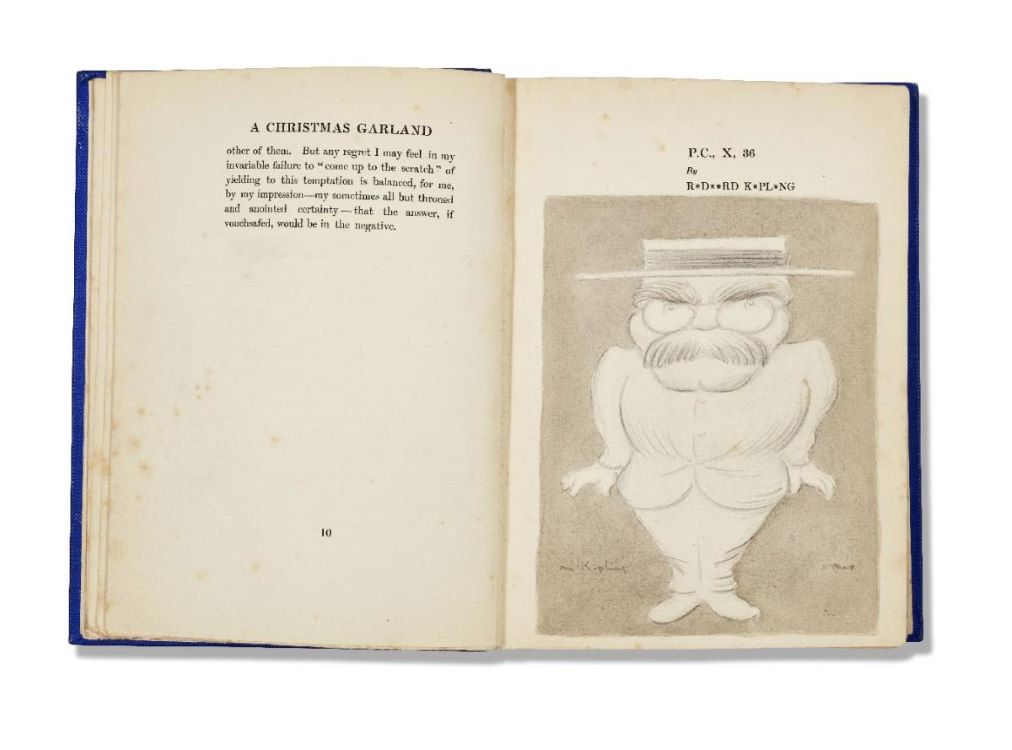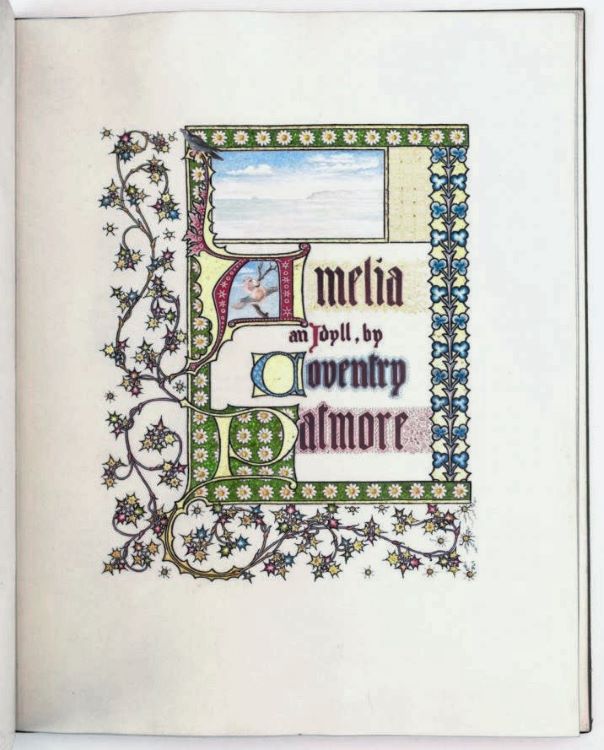Special Collections librarians welcome opportunities to collaborate with faculty and promote the use of our primary sources. Requests for instruction or faculty recommendations for new acquisitions can be sent to Special Collections: https://library.udel.edu/special/contact-us/askspec/
Collections Committee
Special Collections and Museums
April 2022
Selected New Resources, November 2021-March 2022
Aubrey Beardsley, 1872–1898. Design for the spine of Sir Thomas Malory, Le More Darthur, pencil and ink on paper, 1894
In 1892, the unknown Aubrey Beardsley was commissioned to illustrate an elaborate edition of Sir Thomas Malory’s tales of King Arthur and the Round Table. Published first in “parts” and then in multi-volume form, the massive work helped put the young artist on the map. This original design, very much a work of art nouveau, is one of Beardsley’s early masterpieces.
Sir Max Beerbohm, 1872–1956. A Christmas Garland, woven by Max Beerbohm. London: William Heinemann, 1912
This is a truly extraordinary book—the this first edition copy of his matchless collection of parodies of contemporary writers Beerbohm embellished specially as a donation to a Red Cross charity sale held during World War I. The sixteen elaborate drawings, in pencil and watercolor, include caricatures of H. G. Wells, George Bernard Shaw, Thomas Hardy, and Joseph Conrad, among others, along with illustrations. Unlocated for more than a century, the book is now reunited in the Mark Samuels Lasner Collection with the copy in which Beerbohm drew “try out” versions of the sketches and presented to his mother.

Reginald Baliol Brett, Viscount Esher, 1852-1930. Foam. London; New York: Macmillan and Co. 1893
It is not surprising that this key volume of gay verse was published anonymously. The author, married with children and an Establishment figure who moved in the most exalted circles, needed to hide his lifelong homosexual inclinations. Known as the premier political “fixer” during the reign of Queen Victoria (whose letters he edited), Lord Esther served a a courtier to three monarchs. Foam is an extremely rare book, with but five copies recorded in other libraries. Escher inscribed this copy to his future daughter-in-law, the music-hall star and actor Zena Dare.
Coventry Patmore, 1823–1896. Amelia: An Idyll. [London: Chiswick Press, 1878]
Reputedly Patmore’s favorite among his own poems, Amelia was a follow-up to the author’s famous The Angel in the House. The private edition consisted of just 25 copies—20 on paper, 5 of vellum. This is one of two recorded vellum copies illustrated on every page with elaborate paintings in quasi-medieval style by the author’s daughter, Bertha. Born in 1855, and tutored and greatly praised by none other than John Ruskin, Bertha Patmore was one of the most remarkable artists associated with the Arts and Crafts Movement. The Saturday Review described this work when it was shown at the Arts and Crafts Exhibition Society’s 1891 exhibition as “illuminated with a genius worthy of the monastic masters of the fourteenth century.”

Dante Gabriel Rossetti, 1828–1882. Sir Hugh the Heron: A Legendary Tale in Four Parts. London: G. Policori’s Private Press, 1843
The poet-partner’s first work, a poem (inspired by reading Sir Walter Scott he later referred to as “absurd trash”) printed when he was 14 by his grandfather, Gaetano Polidori. This copy has provenance through three generations of the Rossetti family; it first belonged to Rossetti’s sister, Maria, who inscribed the title “Sir Hugh the Heron” on the front wrapper; a manuscript note by brother William Michael Rossetti indicates his ownership follows on the verso, indicating the book came to him from their mother, Frances Mary Lavinia Rossetti; a further inscription presents the volume to William’s daughter, Mary Elizabeth Made Rossetti.
W. T. (William Thomas) Stead, 1849–1912. Portraits and Autographs: An Album for the People. London: [Office of the Review of Reviews], 1890
An assemblage of images and facsimile signatures of the great, the famous, and the creative in Britain (starting with Queen Victoria herself and encompassing aristocrats, politicians, writers, and actors, among others) this complication by the reformist journalist and editor, W. T. Stead, is a prime example of late-Victorian celebrity culture. This is Stead’s own copy, accompanied by two dozen letters from friends (including the philosopher and scientist Thomas Henry Huxley and the feminist Millicent Fawcett) to whom he sent the book as a Christmas present.
Sylvia’s Annual, 1893, edited by Graham R. Tomson. London: Ward, Lock & Bowden, [1893]
This clothbound volume collects eleven of the first twelve monthly issues, December 1892–October 1893, of a magazine aimed at women readers. What is most interesting is that Sylvia’s Journal was pseudonymously edited by the poet, Rosamond Marriott-Watson, who included significant literary work in its pages. The contributors (apart from the editor herself) included Florence Farr, Gleeson White, Violet Hunt, Katherine Tynan, Louise Imogen Guiney, Louise Chandler Moulton, Katherine de Mattos, Jane Barlow, Clementina Black, Nora Hopper, and William Sharp. A set of color plates of women’s fashion is bound in at the back.
